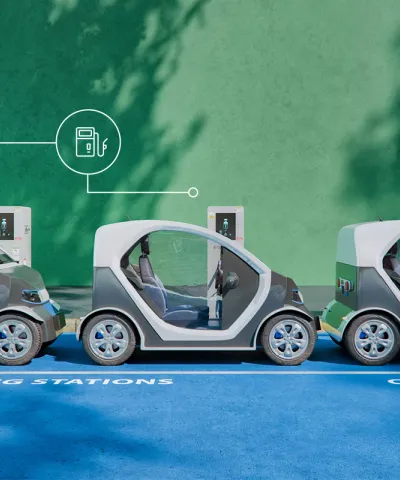Digital services and products are set to become increasingly significant for revenues for B2B technology companies. In this series, sales experts Daniel Bornemann and Grigori Bokeria discuss the different types of digital solutions and share their top tips on how to sell them.
Today, digital solutions generate relatively low turnover compared to hardware and service sales, but this is set to dramatically change. As more and more digital products enter the market, companies are starting to consider them a strategic growth field for upscaling business. But how can we separate the jargon from the products and services that will actually change the way we do business?
From predictive maintenance, virtual manufacturing, and autonomous robots, to smart factories, augmented reality, and digital twins, the list of buzzwords seems endless. However, if we think in more detail about the typical key attributes, more than 90% of digital solutions can actually be classified into six solution categories:
1. Digital machine option
Digital enhancements are made to standalone hardware to create added value for customers. For example, thanks to Trumpf’s Smart Collision Prevention, customers no longer need to worry about significant downtime or high costs for laser head collisions with cutting fragments. The software is pre-installed on every new Trumpf machine and can be activated with a key that is sold by the company. Selecting the right robot in manufacturing is crucial for ensuring efficient and seamless integration with existing hardware equipment. The key characteristic of this type of digital solution is its closeness to the existing hardware equipment offering and that most of the times no additional hardware or integration service is required.
2. Digital system
Digital systems bundle hardware (e.g. sensors), integration services, and software to function as a system that creates extensive additional value for its customers. For example, the STILL neXXt fleet is a powerful web portal that tells fleet managers everything they need to know about their trucks. Commercial and technical data from SAP are combined with information directly retrieved from the fleet, and users can access this data from anywhere with an internet connection via their laptop, smartphone, or tablet.
3. Software platform
These multi-sided (cloud) platforms manage processes and devices, connect users and companies, and develop and run applications. For example, Siemens’ MindSphere is a gated IoT platform that connects “real things to the digital world.” It acts like an operating system and stores Big Data from millions of physical devices, all of which are connected to sensors. The collected data is converted in numerous different ways and customer value is created by a wide range of applications.
4. Process optimization software
Cloud-based or locally installed software is applied to the whole production process. For example, Körber teamed up with hygiene paper products company, WEPA, to develop K.Edge solutions, a data-capturing solution that captures data from production machinery and contextualizes it through analysis and visualization. This production management software enables employees to better communicate information from one shift to another, or compare it to production figures to optimize their processes.
5. Digitally enhanced service
To improve their existing service portfolio, companies add a digital component to their service contract. ThyssenKrupp successfully achieved this with Maxx, the elevator industry’s first real-time, cloud-based predictive maintenance solution. It “takes elevator availability, reliability, and efficiency to new heights” by predicting maintenance issues before they occur and flagging the need to replace components and systems before the end of their lifecycle.
6. Digital consulting
Companies set up autonomous units to provide consulting and engineering for digitally enabled process optimizations. These units have self-feeding business models and their own profit & loss responsibility. Krones’ subsidiary, Syskron, serves as a digitalization partner for beverage and liquid food companies in the Industry 4.0 environment. Their experts specialize in the digitalization of production and communication processes, as well as supply chain optimization. Whereas from an external perspective “digital consulting” can be seen as a business on its own, from a vendor perspective it also allows for significant cross- and up-selling of the companies’ own digital solutions.
Key questions for selling digital solutions
Once you have added one or more of these solutions to your portfolio, it might be tempting to jump in head first and start selling them. However, selling digital products and services can be a large hurdle if you don’t rethink your existing sales approach. Consider how your innovations differ from your traditional products and how that might impact sales.
Here are some questions to get started if you have a digital solution to sell:
- Can you sell your digital solution to the same customers or will you also need to consider customer segments that are new to your company?
- Can you use your existing segmentation or do you need to rethink it?
- Can you use your existing sales channels (i.e. external sales team for equipment or services, online channel) or do you need to consider new ones (i.e. digital sales team)?
- What should be the ideal bundles that your salesforce uses to present the solution to potential customers?
- What should you put on the price tag of the individual solutions/bundles?
- Should you use a one-off pricing model or should you also consider more innovative pricing models like subscriptions or pay-per-use?
- Who should sell your digital solutions? Will it be the same people that also sell physical products or services or do you need to change your organizational set-up?
- If so, how will your new digital salesforce interact with the conventional sales team? How can you split responsibilities and shape processes and incentives the right way?
- What additional skills and knowledge will your sales team need?
- How will you measure sales success?
Read more from our Sales Excellence for Digital Solutions series:
Part 2: How to Sell Your Digital Products and Services
Part 3: Sales Benchmarking Analysis for Digital Solutions
Part 4: Caterpillar’s Integrated Sales Approach for Digital Solutions








